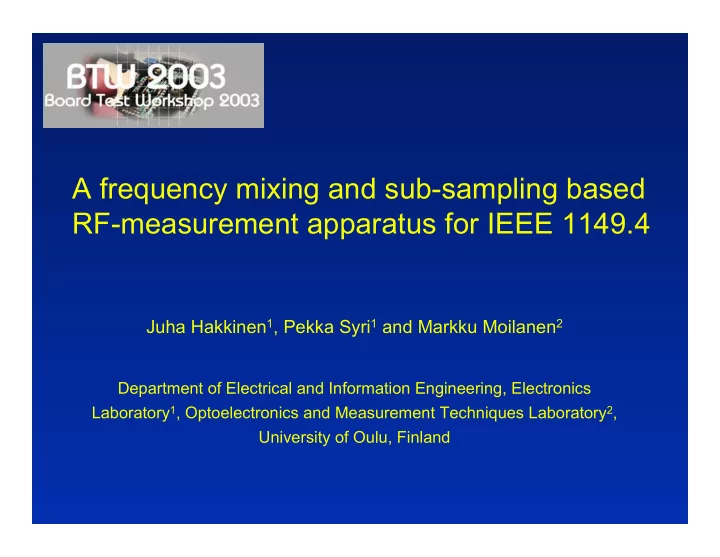

A frequency mixing and sub-sampling based RF-measurement apparatus for IEEE 1149.4 Juha Hakkinen 1 , Pekka Syri 1 and Markku Moilanen 2 Department of Electrical and Information Engineering, Electronics Laboratory 1 , Optoelectronics and Measurement Techniques Laboratory 2 , University of Oulu, Finland
Purpose To demonstrate the possibility of performing radio frequency (RF) measurements in the IEEE 1149.4 environment.
Outline • Motivation and goal • Solution, i.e. circuit realization • Circuit characterization • RF measurement demonstration, i.e. 3 GHz VCO measurements • Repeatability measurements • Conclusions
Motivation Testing and tuning of An emerging testing high-frequency standard IEEE 1149.4 parts of electrical allows the access of systems is extremely selected locations in the PCB for low- time consuming and frequency testing requires expensive test equipment If IEEE 1149.4 could be used also for RF testing, the speed and cost improvements could be considerable in the future
RF measurement in the IEEE 1149.4 environment Apparatus RF (2…3GHz) RF described DUT in this LF (DC…100kHz) presentation DCU AC SCANSTA 400 LF DUT W/V/A PC IEEE 1149.4 demo PCB IEEE 1149.4 capabilities demonstration environment
The Apparatus ZABDC20-2400 f vco ≈ 2 GHz ≈ 2 GHz band-pass ≈ 4 GHz f IF band-stop ( ≈ 100 MHz) φ f out φ f LO -3 dB ≈ 50 kHz ≈ 1.9 GHz φ S/H pulse shaper T f clk ( ≈ 9.995 MHz)
Sub-Sampling 100 MHz signal f c f i (t) time domain t time f i (t) f o (t) T f o (t) t time T frequency domain |F( ω )| |G( ω )| 100 MHz signal 2f c 3f c f c { { { { { { ∆ f ∆ f ∆ f ∆ f ∆ f ∆ f ∆ f f f c f RF f LF copy of =nf c + ∆ f the 100 MHz signal
Measured f out vs. f vco 110 100 90 f out /kHz 80 70 60 50 fclk=9.985050 MHz fclk=9.988390 MHz 40 fclk=9.991011 MHz 30 2 2.01 2.02 2.03 2.04 2.05 2.06 2.07 2.08 2.09 2.1 f vco /GHz
∆ f vco = fvco measurement error 1 fclk=9.985050 MHz fclk=9.988390 MHz 0 fclk=9.991011 MHz ∆ f vco /kHz -1 -2 -3 -4 -5 2 2.02 2.04 2.06 2.08 2.1 f vco /GHz
P out vs. P in -31 2.0GHz 2.01GHz -32 2.02GHz 2.03GHz 2.04GHz 2.05GHz -33 2.06GHz 2.07GHz 2.08GHz 2.09GHz -34 2.1GHz P out /dBm -35 -36 -37 -38 -39 -40 -41 -2 -1 0 1 2 3 P in /dBm
VCO and CLK reference circuits 3.2V 3.2V 2.7V 2.7V FAN FAN 2500 2500 fvco fvco Vtune Vtune VCO VCO 0.7…1.2V 0.7…1.2V 3.23…3.98 GHz 3.23…3.98 GHz VCO box: -3 dB attenuator (LAT-3) VCO box: -3 dB attenuator (LAT-3) CLK box: 74F04 hex inverter CLK box: 74F04 hex inverter • f VCO = 3.23…3.98 GHz • f CLK = 26 MHz
VCO measurement setup f VCO external IEEE 1149.4 ( ≈ 3.23… demo PCB 3.98 GHz) f IF SCANSTA 400 ( ≈ 100 MHz) φ AC φ f LO -3 dB ≈ 3.6 GHz φ S/H pulse shaper W/V/A T f CLK LF reference f out (26.00001 MHz) DCU ≈ 9…100 kHz measurement
f VCO(L) vs. V tune 3.44 3.4 y = 0.2378x + 3.1093 3.36 f VCO(L) /GH 3.32 3.28 measured z LMS 3.24 3.2 0.4 0.6 0.8 1 1.2 V tune /V ⇒ tuning sensitivity = 237.8MHz/V (datasheet 250+/-3MHz/V)
VCO tuning linearity 300 200 f VCO(L) -f LMS /kHz 100 0 -100 -200 -300 -400 0.6 0.7 0.8 0.9 1 1.1 1.2 1.3 V tune /V
Repeatability of measurements Attenuation of DCU -24 -25 Attenuation/dB -26 -27 -28 -29 3 3.05 3.1 f in /GHz
Repeatability measurements LF output power of SCANSTA400 -56 -56.5 P/dBm -57 -57.5 -58 -58.5 3 3.05 3.1 f in /GHz
Repeatability measurements Attennuation of the DCU and LF output power of the SCANSTA400 -24 average maximum Attennuation/dB -25 minimum average scansta maximum scansta -26 minimum scansta attenuation of -27 DCU (P in =0dBm) -28 -29 3 3.02 3.04 3.06 3.08 3.1 f in /GHz ⇒ attenuation of the RF-to-LF circuitry and the output power of the SCANSTA400 vary about ± 0.125 dB and ± 0.15 dB, respectively
Repeatability measurements Frequency measurement error 5.1 5 4.9 4.8 f error /kHz 4.7 4.6 4.5 4.4 4.3 4.2 2.98 3 3.02 3.04 3.06 3.08 3.1 3.12 f in /GHz ⇒ the measurement uncertainty is roughly ± 350 Hz
Conclusions • It is possible to make simple RF measurements in the 1149.4 environment • Combination of mixing and sub-sampling were successfully used to down-convert the RF signal into a low frequency suitable for the standard • The DCU has to be carefully characterized and de- embedded from the measurement system • The repeatability of RF power measurement at the IEEE 1149.4 analogue outputs is ± 0.15 dB • Measurement uncertainty of RF frequency caused by measurement instruments and signal sources is ± 350 Hz.
Recommend
More recommend